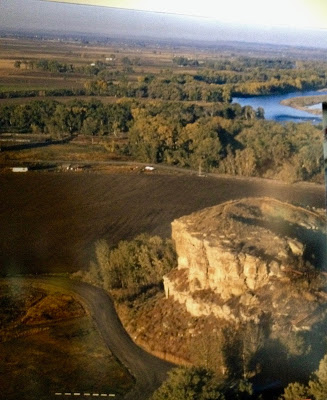This morning, we are in Sidney, MT after spending the night here in a
Richmond Inn and Suites motel. We drove from Billings, MT to Sidney, but we made a major stop at Pompey's Pillar National Monument. We had never heard of it, and were curious, so we checked it out. It was both very interesting historically and a beautiful place to spend some time. We were loath to leave.
Pompey's Pillar is a large, 150-foot-high outcropping of sandstone next to the Yellowstone River. On July 25, 1806, Capt. William Clark, of Lewis & Clark fame, was canoeing up the Yellowstone on his way to reconnoiter with Lewis and his party who were further upstream at the confluence with the Missouri River, and he was struck by this prominent feature. He landed and climbed up the mound, and carved his name into the sandstone, with the date. He named the mound after Sacagewea's son Pompy, of whom he was very fond. He probably recognized as well that it was important to the Crow people, and contains many petroglyphs. Clark, who was a meticulous journalist, made extensive notes on what he did and saw that day, which led others to the spot. Subsequent research by scientists has revealed that this mound bears evidence of 11,000 years of human activity. It was named a N.M. in 2001, and a new Interpretive Center was built in 2006. A commodious stairway was constructed to the top, and by golly, I climbed it. I don't know how many steps, but it was a lot. I guess if it's 150 feet high, and a stair riser is about 6 inches, there must've been 300 steps. And just as many coming down! At the top I met a 76-year old amateur historian who was eager to share the history of the place with anyone interested in listening, which I was. From the top you got a 360 degree view which was magnificent. And of course on the way up there is a special platform from which to view Clark's inscription, covered with bulletproof glass (because so many patriotic Americans were taking pot-shots at it). Hundreds of other patriots have carved
their initials into the rock, in some cases disfiguring early Native-American sacred signs. I guess the Park Service has put an end to that. Places like this raise so many issues and questions concerning our country - like manifest destiny, our relationship to Native-American people's both historically and now, and how they are to be represented in a monument such as this, both historically and now. The Park Service is at least somewhat aware of those issues. I think it is important to have monuments such as this, just because they force us to deal with and think about those issues.
There was a lot we could have seen and done there - we could have stayed much of the day. But we had to keep moving, so we left, and pushed on eastward on I-94. As we got closer to the South Dakota border it began to rain, and got quite windy as well. This raised questions about what to do on Wednesday and where to spend the night. We had to stop and work through all that, and finally decided to stay here in Sidney, which puts us in a convenient place to go to the North Unit of Theodore Roosevelt N.P today. I think going to Isle Royale N.P. tomorrow is out of the question at this point. Just too much. We got our supper tonight at a
Reynolds Super Market which proved to be quite good and very reasonable. And our room is quite nice too. And the window opens - fresh air without a fan - which is quite unusual. We watched PBS News and a
American Experience special on the moon landing which was fascinating. So many things we knew nothing of the time. E.g., who knew about Ed Dwight who was the first African-American pilot to train as an astronaut, whose skill got him into the final group of 14, and whom Bobby Kennedy really wanted to be sent on a space mission, but who was probably dropped from the program because his involvement offended southern senators who chaired Senate committees that funded NASA. He could have been the "Neil Armstrong person."
 |
| The Interpretive Center at Pompey's Pillar |
 |
| Pompey's Pillar. Top: from the base; Bottom: from the air |
 |
| Clark's inscription - under protective glass |
 |
| View of Yellowstone River from the top of Pompey's Pillar |
 |
| Model of Capt. William Clark |
 |
| The eating area at Reynold's super market - with history on the wall |








No comments:
Post a Comment